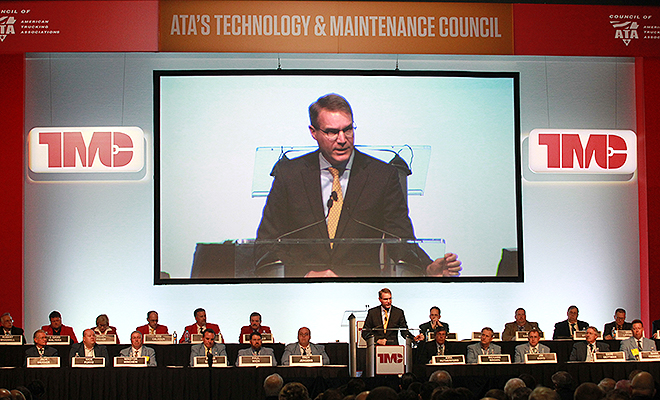Senior Reporter
Spear: Trucking to Play Key Role in Autonomous Policy

ATLANTA — New federal guidance on automated cars and trucks to be unveiled this year will include the input from the trucking industry, American Trucking Associations President Chris Spear said at the Technology & Maintenance Council annual meeting March 5.
Spear also said he continues to fight to clarify a perception that commercial trucks will operate without drivers in the near future. Drivers, he emphasized, will continue to have major roles in heavy trucks and the freight industry. He took issue with media reports that are promoting a rapid adoption of self-driving trucks.
“Technology is cool. It has the ability to attract younger talent into our industry,” Spear said, adding, “but if it’s not taken in a realistic fashion, it also has consequences. It could drive people away from this industry.”
ATA is ensuring a policy update the U.S. Department of Transportation intends to unveil in the coming months addressing guidance for automated trucks will include the group’s insight, Spear said. The industry views autonomous trucks operating on a “driver-assist” model in the foreseeable future, rather than “driverless,” Spear has explained.

Spear by John Sommers II for Transport Topics
Several firms continue to test autonomous trucks across the country with the goal of realizing their adoption in the marketplace.
ATA also is looking to convince members of the Senate Commerce Committee to include trucking-centric provisions in legislation that would facilitate the development of self-driving cars. The bill does not include policy aimed at trucks.
“We have to have a voice. We have to take our seat at the table. We have to tell our story,” Spear stressed.
Federal officials promote the technology’s safety potential. At a policy summit at U.S. DOT last week, Federal Motor Carrier Safety Administration Chief Ray Martinez said automated trucks could save “thousands and thousands of lives.”
“Automation can reduce congestion, which can improve productivity and lift the cost associated with crashes,” Martinez said.
Spear also emphasized a truck driver shortage is a concern on the group’s radar. Last year, ATA launched a workforce development task force to collaborate with policymakers on a fix to driver and technician shortages. Recruiting drivers from the 18- to 21-year-old demographic is a priority.
“A good economy may be good but it also shows that we have a lot of work to do to help grow long-term,” Spear said. “Our personal view at ATA is that we stop talking about this problem, and that we start solving this problem.”
In a recent report by ATA, the shortage of drivers industrywide is estimated at nearly 50,000, and the shortage is projected to increase to 175,000 in almost a decade.





